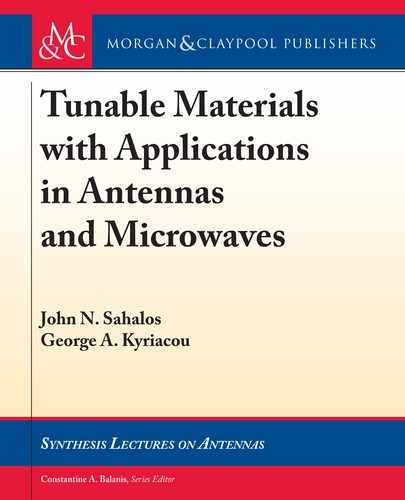
3.23. MAGNETOSTATIC SURFACE WAVES .1 C X / > 0 137
Before moving on to practical, useful, multilayered structures, like dielectric ferrites or
ferroelectric ferrite films, it is worth studying magnetostatic (or spin) waves in some geometries
of circular symmetry (e.g., disks and rods). Another important issue is the damping of spin and
magnetostatic waves, since losses often reveal some hidden physical phenomena while always
better representing practical applications.
3.23.6 MAGNETOSTATIC MODES IN AN INFINITE CIRCULAR
DISK-PERPENDICULAR MAGNETIZATION
To simplify the analysis, let us start with a disk of infinite radius, which was originally studied
by Sparks [21, 42]. is is the same geometry as studied in a past section. e basic difference
here is the employment of circular-cylindrical coordinates . O;
O
; Oz/. Hence, Walker’s Eq. (3.76)
should be appropriately expressed. Recall that the permeability tensor [] as well as the suscep-
tibility X retains the same form for the ( O;
O
; Oz) and ( Ox; Oy; Oz) systems. e former is given
in (2.21). e wave equation in its general form is given in (3.76). To expand it for the ferrite
disk, let us write the grad operator r‰
i
in cylindrical coordinates. en multiply this by the
permeability tensor (3.73) as Œr‰
i
. One may observe then the occurrence of two unexpected
terms containing ˙jk
1
, which cancel each other out when we take the divergence r
Œr‰
i
.
e resulting wave equations for both the ferrite disk and the air region agree with those of Da-
mon and Van De Vaart [37], and read as follows:
Ferrite disk: .1 C X /
1
@
@
@‰
i
@
C
1
2
@
2
‰
i
@'
2
C
@‰
i
@z
2
D 0 (3.176a)
Air outside the sample:
1
@
@
@‰
e
@
C
1
2
@
2
‰
e
@'
2
C
@‰
e
@z
2
D 0 (3.176b)
Recall that the demagnetization factors are the same as those noted in Chapter 2 as N
z
D 1
and N
x
D N
y
D 0 $ N
D N
'
D 0 or the internal DC magnetic field is H
i
D H
0
M
s
, ori-
ented along the normal z-axis. In addition, the same arguments concerning the boundary con-
dition along the z-axis at the Ferrite-air interface z D ˙d=2 should be imposed. For a general
solution of (3.176), let us apply the separation of variables as ‰.; '; z/ D f ./g.'/h.z/. First,
the field continuity conditions at the ferrite-air interface call for the same dependence in and
' coordinates, or g
e
.'/ D g
i
.'/ D g.'/ and f
e
./ D f
i
./ D f ./, namely:
‰
e
.; '; z/ D f ./g.'/h
e
.z/ (3.177a)
‰
i
.; '; z/ D f ./g.'/h
i
.z/: (3.177b)

138 3. FINITE FERRITE SAMPLES
It is worth elaborating on the ferrite case, applying the separation of variables in (3.176a)
to yield
@
@
@f ./
@
C
(
k
2
zi
.1 C X /
2
n
2
)
f ./ D 0: (3.178)
In the '-direction, the eigenfunction should be of the form e
j n'
or e
j n'
, where n D
0; 1; 2; : : : due to the 2 periodicity in angle-'. Moreover, in the z-direction, a standing wave
with wavenumber k
zi
should be assumed inside the ferrite:
h
i
.z/ D A
z
cos
.
k
zi
z
/
C B
z
sin
.
k
zi
z
/
: (3.179)
In order to satisfy the radiation condition at infinity, an exponential decay must be consid-
ered in the air region as e
˛z
or k
ze
D j˛. Equation (3.176) can be adapted for the air region
by just setting X ! 0 and k
zi
! k
ze
. e radial wavenumber k
can then be defined as:
k
2
D k
2
ze
D .j˛/
2
D ˛
2
, k
D ˛: (3.180a)
To get a volume magnetostatic wave, k
zi
should be real. Furthermore, for the field to
propagate in the -direction, the corresponding wavenumber (k
) should also be real. Observ-
ing (3.178) one may write
k
2
D k
2
zi
=.1 C X / , k
D k
zi
=
p
.1 C X /: (3.180b)
Asking for k
to be real is equivalent to the expected search for volume magnetostatic
waves in the frequency range defined by .1 C X / < 0 and given in Eq. (3.133b). In turn, (3.178)
reads as follows:
2
d
2
f ./
d
2
C
df ./
d
C
k
2
2
n
2
f ./ D 0: (3.181)
is is an ordinary Bessel differential equation. When an infinitely extending slab is con-
sidered, the appropriate general solutions are Hankel’s functions H
.2/
n
.k
/ of the second kind,
which represent waves propagating in the positive O direction for the assumed e
j!t
temporal
dependence. It should be noticed that H
.1/
n
.k
/ represents waves propagating in the negative
O direction. Since the final goal is to study finite disks, it is preferable to consider standing-wave
solutions in terms of Bessel’s J
n
.k
/ or Newman’s functions Y
n
.k
/. Furthermore, Y
n
.k
/
tends to infinity at ! 0. us, only J
n
.k
/ can be adopted.
Furthermore, the corresponding analysis in Cartesian coordinates revealed that the nor-
mally biased infinite film supports both symmetric (or even) and anti-symmetric (or odd) modes,
proportional to cos.k
zi
z/ and sin.k
zi
z/, respectively. However, both modes can be combined into
a single expression by exploiting a simple trigonometric identity:
cos
z
n
2
D
8
<
:
.1/
n=2
cos.z/ even modes n D 0; 2; 4; : : :
.1/
.n1/=2
sin.z/ odd modes n D 1; 3; 5; : : : :
(3.182)
..................Content has been hidden....................
You can't read the all page of ebook, please click here login for view all page.
